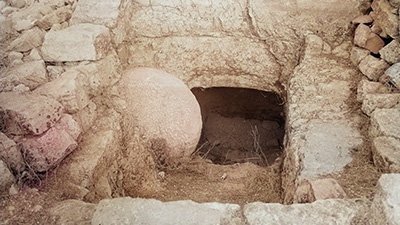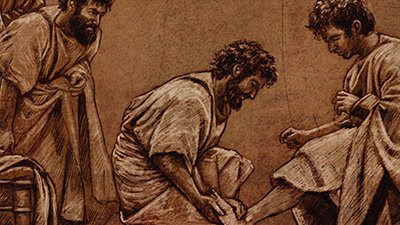Jesus
Jesus Christ is God incarnate, the second person of the Trinity, our creator, the resurrected savior and redeemer, and the only means of salvation for sinners.
Jesus: Overview
Jesus of Nazareth was a Jewish carpenter and teacher in the first century A.D. Jesus is the Christ or Messiah (Anointed One) of Israel. He was born as God in the flesh, lived among men, and taught a “new covenant” in the Jewish tradition. He was crucified by Roman authorities around A.D 30. After he died, Jesus was buried and rose on the third day to prove his power over death. His life, ministry, miracles, death, and resurrection point to his mission: Jesus Christ is both God and the Savior of the world.
Contents
- Did Jesus Really Exist?
- Genealogy & Birth of Jesus
- Jesus’ Life & Ministry
- Jesus’ Teaching & Miracles
- Sermon on the Mount
- Biblical Sources for Jesus
- Extrabiblical Sources for Jesus
- The “Lost” Years of Jesus
- Was Jesus Married?
- Jesus’ Death: Did He Really Die?
- Did the Disciples Just Hide His Body?
- Jesus’ Resurrection
- Liar, Lunatic, or Lord?
- Is Jesus God?
- The Good News of Jesus
Did Jesus Really Exist?
Yes, Jesus existed. Jesus of Nazareth was a Jewish man born at the end of the first century B.C. He lived and taught in ancient Palestine, a Roman province, in the first century A.D.
Jesus’ life, death, burial, resurrection, and ascension are attested in the biblical documents in the first four books of the New Testament known as the Gospels: Matthew, Mark, Luke, and John. Other extra-biblical documents also point to Jesus’ actual life and early followers.

Genealogy & Birth of Jesus
Jesus was miraculously conceived without sexual union when the Holy Spirit overshadowed his mother, Mary (Luke 1:35). He was then born in the line of some of the most well-known people in the Old Testament—including several women.
There are two separate genealogies recorded in the Gospels. In Matthew’s Gospel (Matthew 1:1–17), the lineage starts at Abraham and goes through King David to Jesus’ birth, likely traced through Mary. In Luke’s gospel (Luke 3:23–38), Jesus’ genealogy traces backward to Adam through his earthly adoptive father’s lineage. In both genealogies, we can see how Jesus was rightfully called the Son of David, according to Jewish messianic prophesies (Jeremiah 23:5–6).
Jesus’ Life & Ministry
Jesus grew up in Nazareth, a small town in the region of Galilee at the edge of the eastern Mediterranean Sea. He was raised as an observant Jew, had brothers and sisters, and was trained to work as a carpenter (Mark 6:3).
Around the age of 30, he was baptized by the prophet John the Baptist and began ministering as an itinerant rabbi, a Jewish teacher (Mark 1:9–15). He called disciples to himself and taught the crowds who gathered around him. His followers eventually proclaimed him to be the Christ, or “anointed one” (Matthew 16:16). “Christ” (Messiah: Hebrew) was a royal and divine title in Jewish theology.

Jesus’ Teaching & Miracles
Jesus taught on many subjects including love, the kingdom of God, repentance, non-hypocritical faith, forgiveness, discipleship, prayer, marriage, divorce, eternal judgment, and eternal life for those who believed. His favorite method of teaching was through “parables,” which are short stories designed to impart a spiritual lesson.
Another critical aspect of Jesus’ ministry was miracles. The purpose of his miracles was to show that he has power over disease, ailment, nature, and death. Throughout his ministry, Jesus performed the following miracles among others:
-
Turned water into wine (John 2:1–11)
-
Healed a paralytic (Mark 2:1–12)
-
Healed a withered hand (Mark 3:1–3)
-
Calmed a storm (Mark 4:35–41)
-
Healed a servant from afar (Luke 7:1–10)
-
Revived a dead man (Luke 7:11–17)
-
Healed a man with leprosy (Matthew 8:2–4)
-
Healed a bleeding woman (Luke 8:43–48)
-
Healed a man born blind (John 9:1–12)
-
Fed the multitude (Matthew 14:13–21)
-
Walked on water (Matthew 14:22–33)
-
Cast out demons (Matthew 17:14–21)
-
Healed a man with a severed ear (Luke 22:50–51)
-
Resurrected himself (Mark 16:1–7)
Sermon on the Mount
Jesus’ most-famous sermon was the Sermon on the Mount (Matthew 5–7). In this collection of sayings, Jesus laid out some of his best-known teachings, including the Lord’s Prayer. It is Jesus’ longest continuous teaching discourse found in the New Testament.
The sermon promised blessings on those who display certain characteristics (e.g., poor in spirit, merciful) (Matthew 5:3–12). It included Jesus’ mission to fulfill the Old Testament law (Matthew 5:17–20). He taught on hatred and murder (Matthew 5:21–26), lust, adultery, divorce (Matthew 5:27–32), giving (Matthew 6:1–3), prayer and fasting (Matthew 6:4–18), and more. The sermon concluded with a parable encouraging his hearers to follow him and warning those who would ignore his teaching (Matthew 6:24–28).
Biblical Sources for Jesus
The primary source material for Jesus’ life is the four Gospels: Matthew, Mark, Luke, and John. These biographies each provide a different perspective on the life and ministry of Jesus. The first three Gospels, known as the Synoptics, are arranged in a somewhat-chronological order. The Gospel of John is arranged more topically with a heavy interest in theological themes.
In addition, every other New Testament manuscript (except the epistle of 3 John) mentions Jesus by name. These documents often explore the teaching of the apostles and the early church. However, there are some mentions of events in Jesus’ life, especially his death, burial, and resurrection (e.g., 1 Corinthians 15:1–11).

Extra-biblical Sources for Jesus
There are multiple extra-biblical sources that mention Jesus. These ancient documents further bolster the historicity of the biblical sources:
-
Josephus (A.D. 37–101)
-
Thallus (A.D. 52)
-
Tacitus (A.D. 56–120)
-
Mara-Serapion (A.D. 70)
-
Phlegon (A.D. 80–140)
-
Pliny the Younger (A.D. 61–113)
-
Suetonius (A.D. 69–140)
-
Lucian of Samosata (A.D. 115–200)
-
Celsus (A.D. 175)
-
Jewish Talmud (A.D. 400–700)
-
The Toledat Yeshu (A.D. 1000)
The “Lost” Years of Jesus
The so-called “lost” years of Jesus occurred from the time 12-year-old Jesus met the religious leaders (Luke 2:42–52) to when the 30-year-old Jesus began his earthly ministry (Luke 3:23). The Bible makes no mention of what Jesus did during those years.
Many have tried to fill this narrative gap. Some have suggested he traveled to Britain (twelfth century A.D.). More have suggested he went to India (1869), and others have suggested he visited Tibet, Persia, Assyria, Greece, and Egypt (1908). All the stories that place Jesus outside the ancient near-East arose at least 1,000 years after his resurrection. According to all early biblical and extra-biblical sources, the man Jesus lived only in first-century Roman Palestine.
Was Jesus Married?
No, Jesus was not married while on earth. The Bible does not give us any reason to think he was married, and there are numerous reasons to conclude that he was not married based on the Bible and early Christian writings.
-
Jesus commended his mother to the Apostle John’s care—no wife is mentioned (John 19:25–27).
-
Paul makes no mention of Jesus’ marriage when discussing Peter’s marriage (1 Corinthians 9:5).
-
The church is called “the bride of Christ,” unlike any other woman (Ephesians 5:23–32).
-
An early bishop Clement of Alexandria affirmed Jesus’ singleness (The Stromata, III.6.49).
-
Another early Christian teacher Tertullian called Jesus “unmarried” (On Monogamy, 5).

Jesus’ Death: Did He Really Die?
At the end of Jesus’ earthly teaching ministry, Jesus died. Jesus’ death is described in all four Gospels, multiple New Testament epistles, and other ancient sources. He was crucified on a cross, a punishment reserved for the worst of criminals in Roman jurisprudence. The Romans were very efficient at killing people.
Some critics have suggested that Jesus merely “swooned” on the cross and did not actually die. They propose that Jesus fainted and later “revived” in the tomb after he was taken down from the cross. This hypothesis has no basis in the primary source documents. No man ever survived first-century whipping with iron balls and bone pieces (scourging), followed by Roman crucifixion.
Did the Disciples Just Hide His Body?
Another critical theory is that Jesus’ disciples hid his body after he died. These critics propose that the disciples took Jesus’ body after the crucifixion and faked his resurrection. This was the story the Jewish leaders fabricated that allowed the soldiers who guarded the tomb not to get punished for losing Jesus’ body (Matthew 28:11–15).
There are multiple problems with this hypothesis. For one, nobody steals bodies from Roman saldiers. According to the extra-biblical first century A.D. Nazareth Inscription, grave robbers were punished by death. Additionally, the Apostles would have been the likely culprits in the scheme. And most of the apostles died for believing in a resurrected Jesus. Few people die for their faith, but nobody dies for what they know is a lie. And finally, this theory does not account for the resurrection appearances to over 500 witnesses (1 Corinthians 15:6). The disciples did not hide Jesus’ body.

Jesus’ Resurrection
On the third day after being placed in the tomb, Jesus rose from the dead (Luke 24:6–7).
In all four Gospels, we read about the resurrection of Jesus from the dead. After a cruel execution, Jesus was resurrected with a new, glorified body. His new body was unlike his previous body in that he could appear in the midst of his disciples (John 20:19, 20:26). But it was similar to his previous body in that he could still eat fish (Luke 24:42–43). The important fact is that God the Father raised Jesus from the dead and “loosed the pangs of death” for all believers (Acts 2:24).
Liar, Lunatic, or Lord?
In Mere Christianity, C.S. Lewis proposes a trilemma related to the nature of Jesus. Lewis invited people to make a decision about Jesus—and there are only three reasonable choices. Either he was a liar, a lunatic, or the Lord he claimed to be. According to Lewis,
I am trying here to prevent anyone from saying the really foolish thing that people often say about Him: “I’m ready to accept Jesus as a great moral teacher, but I don’t accept his claim to be God.” That is the one thing we must not say. A man who was merely a man and said the sort of things Jesus said would not be a great moral teacher. He would either be a lunatic—on a level with the man who says he is a poached egg—or else he would be the Devil of Hell.
You must make your choice.
Either this man was, and is, the Son of God: or else a madman or something worse. You can shut him up for a fool, you can spit at Him and kill Him as a demon; or you can fall at His feet and call Him Lord and God. But let us not come up with any patronizing nonsense about His being a great human teacher. He has not left that open to us. He did not intend to.
Is Jesus God?
Yes, Jesus is God the Son. Jesus must be viewed as God by virtue of the fact that he has the names, attributes, and the authority of God; he does the works of God; and he is worshiped as God (John 20:28). God exists as a Trinity—one God in three persons, God the Father, God the Son (Jesus), and God the Holy Spirit.
On multiple occasions, Jesus’ divinity is also taught directly in Scripture. The prophet Isaiah affirmed the divinity of the Messiah 700+ years before he was born (Isaiah 9:6). The author of Hebrews taught Jesus’ divinity (Hebrews 1:8), and Paul acknowledged Jesus’ divinity as well (Titus 2:13). However, the most dramatic affirmation of Jesus’ divinity is from John 1:1 in which John proclaimed that Jesus was God at the beginning of creation: “In the beginning was the Word, and the Word was with God, and the Word was God.”
Conclusion: The Good News of Jesus
In conclusion, Jesus Christ, though totally sinless, suffered death and God the Father’s just wrath against sinners on behalf of mankind for their sin. He died to satisfy the righteous demands of the holiness and justice of God, his Father.
Jesus was the perfect sacrifice. He died on a cross, but on the third day, he rose again, conquering death, so that all who truly believe in him, repent of their sin, and trust in him (rather than their own merit) are able to come back to God and live for eternity with their Creator.
Therefore, “He who believes on Him is not condemned, but he who does not believe is condemned already, because he has not believed in the name of the only-begotten Son of God” (John 3:18).
Jesus Topics
-
Gospel
The message of the gospel—Christ’s death and resurrection for the salvation of mankind—is the message the world desperately needs to hear.
-
Incarnation
The incarnation—when Jesus Christ, who is God the Son, became flesh and lived among us—is vital to the precious doctrine of salvation.
-
Jesus’ Birth
How accurate is the common perception of baby Jesus born in a lowly stable? Was Jesus really born of a virgin? What are the implications of the God-child?
-
Jesus’ Crucifixion
Jesus Christ, the Creator of the universe, took on flesh and endured the horror of death by crucifixion in order that man might be reconciled to God.
-
Jesus Is God
Is Jesus truly God? There are many cults and religions today that deny His deity. What is the truth about Jesus Christ? We turn to the Scriptures for answers.
-
Resurrection
Did Jesus truly rise bodily from the dead, or is the account of his Resurrection simply one of the greatest hoaxes of all time?
Articles About Jesus
-
Narrow-Minded . . . Like Jesus
Bible-affirming Christians are often accused of being narrow minded. However, Christ himself set an example of unashamedly holding fast to the truth.
-
April 1, 2024 from Answers Magazine
A close look at the first book of Scripture reveals promises, pictures, foreshadowings, and geneaologies of the coming Messiah.
-
March 29, 2024 from Answers in Depth
The Gospels accurately describe a first-century burial
-
Dec. 2, 2023 from Answers in Depth
David’s Psalms point to Jesus, the Son of David.
-
Nov. 24, 2023 from Answers in Depth
Are we understanding this well-known prophecy correctly?
-
Aug. 14, 2016 from Answers Magazine
The gospel is not something God hid until Jesus came in the flesh. After Adam’s Fall, God shared the seeds of a plan He had already worked out.
-
Why Did Jesus Take on a Human Nature?June 14, 2016
Aspects of Jesus’ humanity are often overlooked, but it is important to understand why Jesus took on flesh and dwelt among us (John 1:14).
-
April 1, 2016 from Demolishing Supposed Bible Contradictions: Volume 2
Why are people called fools in Scripture even though Jesus told us not to call people fools?
-
How Colossians 1 Combated Erroneous Teaching in the ChurchFeb. 4, 2016
In order to combat the erroneous teaching that was infiltrating the church in Colossae, Paul reminded them of the supremacy of Jesus Christ.
-
Evolution and the Atonement of Jesus ChristAug. 28, 2015
If the Cross was not required to save sinners, then why did God permit Jesus to face such torture if it wasn’t even necessary?
-
Semi-Technical In-Depth ArticleReview of The Lost Gospel by Simcha Jacobovici and Barrie WilsonJan. 22, 2015 from Answers in Depth
The Lost Gospel is yet another attempt to show Jesus as the husband of Mary Magdalene, and this time Jacobovici claims to have proof.
-
The Battle to Keep Christ in ChristmasDec. 13, 2013
If you told the average American 50 years ago that “in the 21st century, America will take Christ out of Christmas and make it nothing but a pagan holiday,” I’m sure most would have responded with something like, “No—not here—that would never happen.” But it is happening.
-
Why Did Jesus Weep?Nov. 5, 2013
There were occasions in Scripture when Jesus wept and lamented. It seems logical to ask ourselves then, why did Jesus weep and lament?
-
Jewish, Roman Leaders See Jesus as ThreatMarch 30, 2013 from News to Know
Jesus—come from God the Father with authority to deal with sin—is perceived as a threat by the Jewish and Roman leaders.
-
Intercultural Communication Lesson Demonstrates What Not to DoMarch 30, 2013 from News to Know
Florida Atlantic University has now issued an apology for instructing students to stomp on the name of Jesus.
-
Book Chapter7.5 Danger No 5: Relativation of Jesus’ Work of RedemptionJan. 10, 2013 from Did God Use Evolution?
The first man’s fall into sin was a real event and is the direct cause of sin in this world; everybody else became tainted.
-
Feedback ArticleWas Jesus Married?Sept. 21, 2012 from Feedback
Earlier this week, headlines announced a new discovery that shows Jesus was married. Is there any basis for such a claim? Would it even matter if Jesus was married?
-
Book ChapterWilderness or Wedding?July 2, 2012 from Demolishing Supposed Bible Contradictions: Volume 2
Mark’s Gospel claims Jesus was “immediately” driven into the wilderness after His baptism, but John seems to disagree. Ron Dudek examines the context of these passages.
-
Magazine Department ArticleMore QuestionsApril 1, 2012 from Answers Magazine
“Early man”—the field is loaded with unanswered questions.
-
Book ChapterDid Jesus Go Up or Down the Mountain?Jan. 10, 2012 from Demolishing Supposed Bible Contradictions: Volume 2
Did Jesus go up or down the mountain to deliver the Sermon on the Mount? Tim Chaffey, AiG–U.S., explains.
-
Book ChapterFirst ImpressionsJan. 3, 2012 from Demolishing Supposed Bible Contradictions: Volume 2
Did Jesus first appear to the eleven disciples on a mountain in Galilee or in Jerusalem behind closed doors?
-
Nov. 2, 2011 from Answers Magazine
Our contemporary Christian culture has slipped into some flawed views of biblical authority. Among them is the attitude that it’s good to know what the Bible says but we can turn to other sources
-
Feedback ArticleThe Temple CleansingAug. 26, 2011 from Feedback
Tim Chaffey, AiG–U.S., explains why John’s account of the temple cleansing must necessarily have been a different event from the one found in the Synoptic Gospels.
-
Book ChapterWhen Did Jesus Cleanse the Temple?Aug. 16, 2011 from Demolishing Supposed Bible Contradictions: Volume 2
John states that Jesus cleansed the temple early in His ministry, but the other Gospels place the temple-cleansing near the end of His ministry. Tim Chaffey, AiG–U.S. explains these accounts.
-
DevotionalWhy Did Our Savior Also Need to Be God?Dec. 31, 2010
Since Jesus was also God, he was able to pay the infinite penalty for us and thus provide a bridge between us and God the Father.
Recommended Resources

Answers in Genesis is an apologetics ministry, dedicated to helping Christians defend their faith and proclaim the good news of Jesus Christ.
- Customer Service 800.778.3390
- © 2024 Answers in Genesis


































